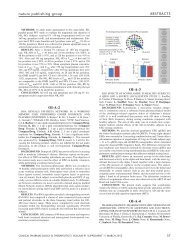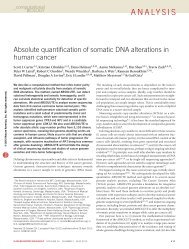open access: Nature Reviews: Key Advances in Medicine
open access: Nature Reviews: Key Advances in Medicine
open access: Nature Reviews: Key Advances in Medicine
Create successful ePaper yourself
Turn your PDF publications into a flip-book with our unique Google optimized e-Paper software.
ather <strong>in</strong>formation on the 95 th percentile of<br />
semen analysis data. As such, they <strong>in</strong>form<br />
the reader that 95% of men who achieve<br />
pregnancy with<strong>in</strong> 12 months of try<strong>in</strong>g will<br />
have sperm concentrations of >15 million<br />
cells/ml, >40% of observed sperm demonstrat<strong>in</strong>g<br />
good movement, and >4% of sperm<br />
with normal morphology.<br />
Unfortunately, these criteria do not<br />
predict the likelihood of achiev<strong>in</strong>g a pregnancy<br />
<strong>in</strong> the follow<strong>in</strong>g 12 months, which<br />
is typically when urologists first see these<br />
patients <strong>in</strong> consultation. Furthermore, the<br />
reference range must be viewed as a cont<strong>in</strong>uum,<br />
given that many patients at the low<br />
end of the range might still achieve pregnancy,<br />
and men at the high end might not.<br />
The nondef<strong>in</strong>itive nature of these guidel<strong>in</strong>es<br />
confirms the need for further sophisticated<br />
test<strong>in</strong>g—such as DNA fragmentation analysis,<br />
oxidative stress analysis and sperm<br />
evaluation for genomic, proteomic and<br />
metabolic factors—<strong>in</strong> certa<strong>in</strong> cases of<br />
male factor or unexpla<strong>in</strong>ed <strong>in</strong>fertility. For<br />
example, a patient whose semen parameters<br />
fall with<strong>in</strong> the new reference ranges but<br />
has not achieved pregnancy might benefit<br />
from DNA fragmentation test<strong>in</strong>g to identify<br />
subtle sperm abnormalities. Esteves et al. 2<br />
have analyzed the new reference values<br />
and highlight further issues that may face<br />
the urologist, <strong>in</strong>clud<strong>in</strong>g whether the referral<br />
of male partners will decrease, whether<br />
we were previously overtreat<strong>in</strong>g our male<br />
patients and how to better <strong>in</strong>terpret these<br />
reference values by focus<strong>in</strong>g on the 50 th<br />
percentile of data.<br />
Over the past decade, progress <strong>in</strong> the<br />
field of assisted reproduction has led to a<br />
change <strong>in</strong> the management of severe male<br />
factor <strong>in</strong>fertility not amenable to medical<br />
or surgical correction. Currently, <strong>in</strong>tracytoplasmic<br />
sperm <strong>in</strong>jection (ICSI) is<br />
the treatment of choice for patients who<br />
suffer from either severe oligospermia<br />
or non obstructive azoospermia (NOA).<br />
Historically, any motile sperm present <strong>in</strong> the<br />
ejaculate would be preferentially utilized for<br />
ICSI. Alternatively, if no sperm were found<br />
<strong>in</strong> the ejaculate, sperm surgically extracted<br />
from the testis were used <strong>in</strong>stead. When<br />
very low numbers of sperm were present<br />
<strong>in</strong> the ejaculate and <strong>in</strong>itial ICSI results with<br />
motile ejaculated sperm were poor, then<br />
testis sperm was considered.<br />
Evidence aga<strong>in</strong>st this ejaculate-first<br />
approach was recently reported by Hauser<br />
et al., 3 who found that fertilization rates <strong>in</strong><br />
patients with relative or virtual azoospermia<br />
were higher when fresh or frozen-thawed<br />
testicular sperm cells were used than when<br />
ejaculated sperm cells were used. This<br />
f<strong>in</strong>d<strong>in</strong>g is particularly <strong>in</strong>terest<strong>in</strong>g consider<strong>in</strong>g<br />
that although more motile sperm<br />
cells were found <strong>in</strong> the ejaculated specimens<br />
than <strong>in</strong> the testicular samples, the<br />
quality of embryos from testicular sperm<br />
(fresh and frozen) was significantly higher<br />
than of those from ejaculated sperm. This<br />
observa tion led the authors to conclude that<br />
it is the source of sperm cells, and not their<br />
motility, that plays a crucial role <strong>in</strong> fertility<br />
outcome. This pilot study suggests a possible<br />
role for testicular sperm extraction<br />
(TESE) coupled with ICSI <strong>in</strong> patients with<br />
severe oligo asthenospermia or relative or<br />
virtual azoo spermia.<br />
If testicular sperm leads to better fertility<br />
outcomes, does it matter if fresh or<br />
frozen-thawed testicular spermatozoa are<br />
retrieved? Accord<strong>in</strong>g to Hauser et al., 3 the<br />
answer is yes. While frozen-thawed spermatozoa<br />
may be more conveniently obta<strong>in</strong>ed,<br />
the researchers found that for patients with<br />
virtual or relative azoospermia, fresh testis<br />
sperm yielded better implantation rates<br />
than frozen testicular sperm.<br />
Although these results support the use<br />
of fresh testicular sperm for patients with<br />
relative or virtual azoospermia, there is<br />
still no consensus on the best approach for<br />
retriev<strong>in</strong>g testis sperm from men with pure<br />
NOA. This year, the value of diagnostic testis<br />
biopsy <strong>in</strong> the era of ICSI was addressed by<br />
Kalsi et al., 4 who provide evidence that<br />
microsurgical TESE (m-TESE)— <strong>in</strong>troduced<br />
by Schlegel and Li 5 <strong>in</strong> 1998—is the optimum<br />
sperm retrieval method <strong>in</strong> patients with<br />
NOA, preferential to f<strong>in</strong>e-needle aspira tion<br />
and traditional TESE.<br />
Researchers were able to successfully<br />
retrieve spermatozoa from 50 of 100 men<br />
with NOA who underwent m-TESE at their<br />
center, which <strong>in</strong>cludes a success rate of 57%<br />
<strong>in</strong> men with previously failed attempts at<br />
sperm retrieval. The only significant positive<br />
predictor of a successful retrieval was<br />
a previous histological diagnosis of hypospermatogenesis,<br />
and therefore the authors<br />
recommend aga<strong>in</strong>st the common practice<br />
of perform<strong>in</strong>g isolated diagnostic testicular<br />
biopsies on men with NOA, and suggest<br />
<strong>in</strong>stead that biopsy should always be comb<strong>in</strong>ed<br />
with a TESE procedure. Therefore,<br />
the take home message for any urologist<br />
treat<strong>in</strong>g a patient with NOA is to either<br />
proceed with a comb<strong>in</strong>ed diagnostic testis<br />
biopsy and send tissue to an andrology laboratory<br />
for process<strong>in</strong>g and cryo preservation,<br />
or to refer the patient to a reproductive<br />
<strong>Key</strong> advances<br />
UROLOGY<br />
■ The updated 5 th edition of the WHO<br />
semen guidel<strong>in</strong>es <strong>in</strong>cludes significant<br />
changes from prior versions and is the<br />
first edition to <strong>in</strong>clude evidence-based<br />
data 1<br />
■ In certa<strong>in</strong> cases, testicular sperm may<br />
be used for <strong>in</strong>tracytoplasmic sperm<br />
<strong>in</strong>jection, <strong>in</strong> preference to ejaculated<br />
sperm, for patients with relative or virtual<br />
azoospermia 3<br />
■ Diagnostic testis biopsy alone (without<br />
tissue process<strong>in</strong>g) has limited value<br />
<strong>in</strong> the management of nonobstructive<br />
azoospermia 4<br />
■ The underly<strong>in</strong>g cause of hematospermia<br />
can be evaluated us<strong>in</strong>g transrectal<br />
ultrasonography 6<br />
■ F<strong>in</strong>asteride is a feasible treatment<br />
option for men with recurrent idiopathic<br />
hematospermia 7<br />
urologist who has this capability. Our<br />
current approach is to beg<strong>in</strong> with a standard<br />
TESE and if no sperm are observed to<br />
proceed with an immediate m-TESE.<br />
Abnormal f<strong>in</strong>d<strong>in</strong>gs <strong>in</strong> ejaculate are not<br />
always related to male factor <strong>in</strong>fertility. In<br />
fact, one of the most frequently encountered<br />
problems <strong>in</strong> general urology is hematospermia,<br />
which can be a cause of great<br />
concern and anxiety for affected men. Until<br />
recently, hematospermia was assumed to<br />
be idiopathic and patients were reassured<br />
that their condition was benign. A recent<br />
study by Zhao et al., 6 however, may alter the<br />
urologist’s approach to hematospermia. In<br />
their study, researchers performed transrectal<br />
ultrasonography on 270 men with<br />
hematospermia, and found abnormalities<br />
<strong>in</strong> 95% of the cohort. These abnormalities<br />
were universally benign <strong>in</strong> patients under<br />
40 years of age, <strong>in</strong>clud<strong>in</strong>g prostatic calcifications,<br />
ejaculatory duct calculi, and benign<br />
prostatic hyperplasia. Patients over the age<br />
of 40 years, however, were significantly<br />
more likely to have a malignant disease; 8<br />
Courtesy of A. Kilchevsky, Yale–New Haven Hospital, USA<br />
KEY ADVANCES IN MEDICINE JANUARY 2012 | S83








